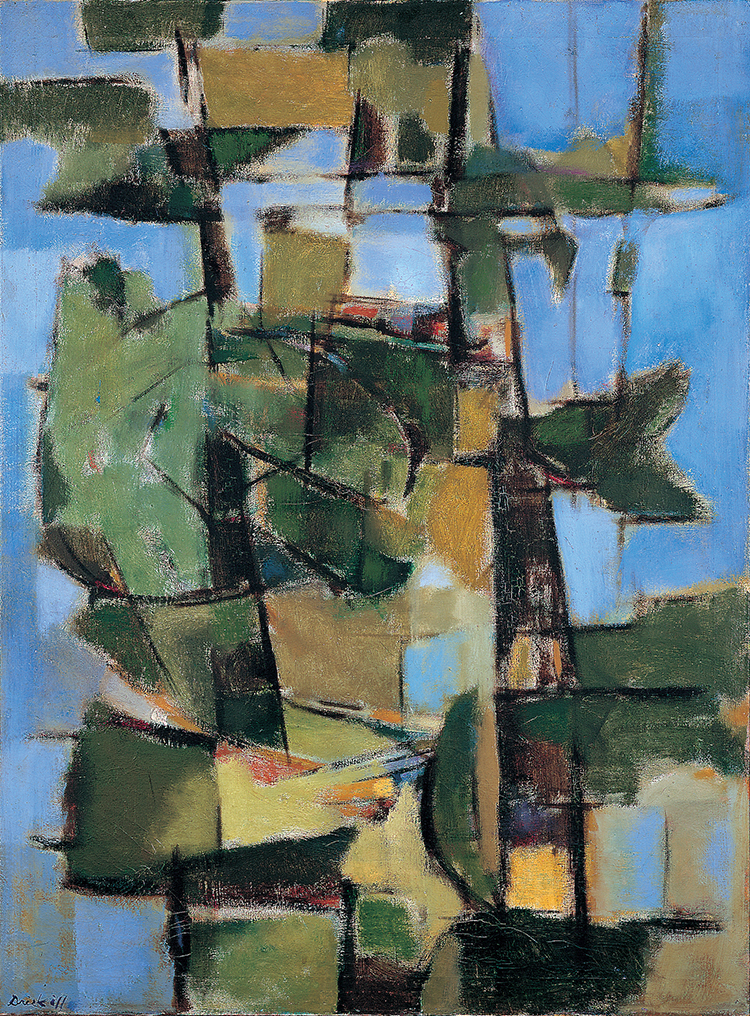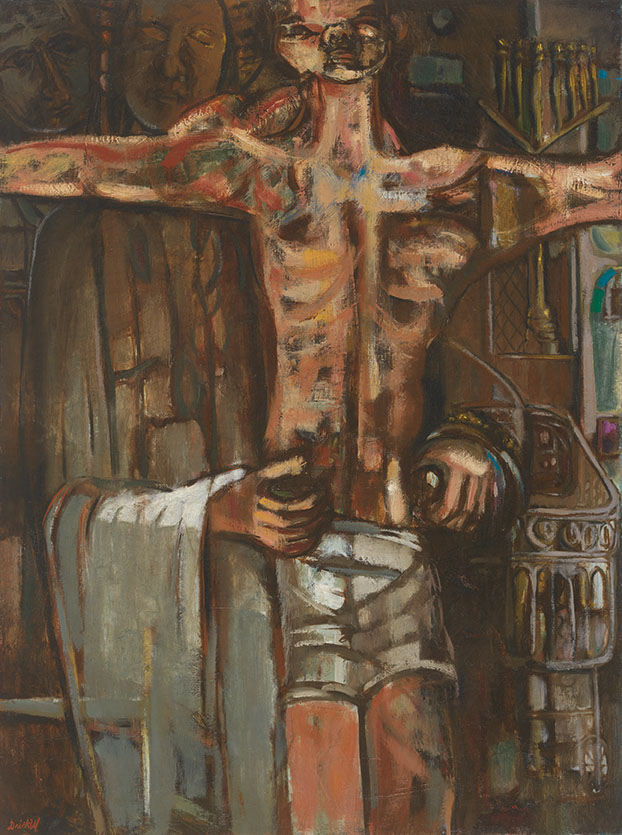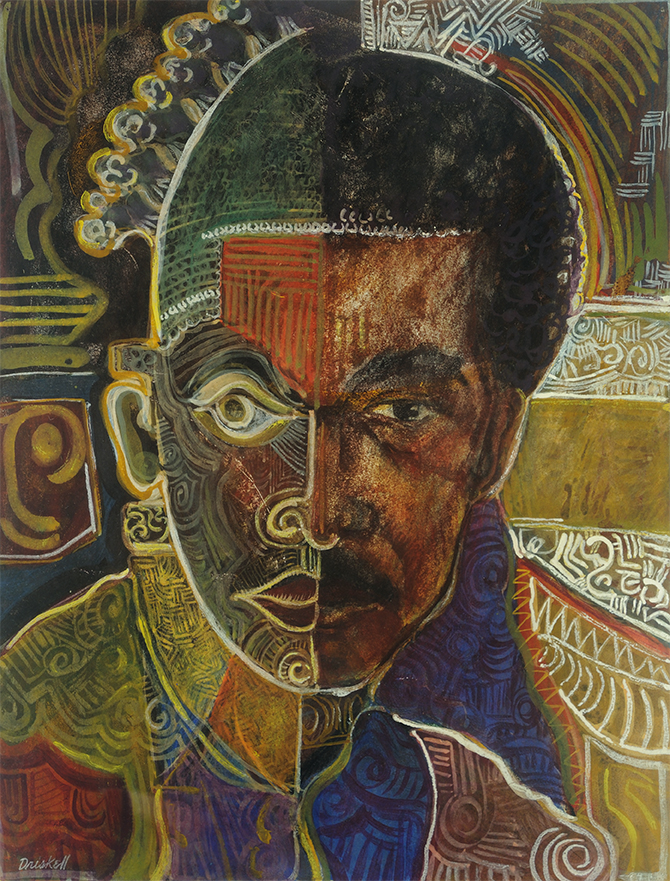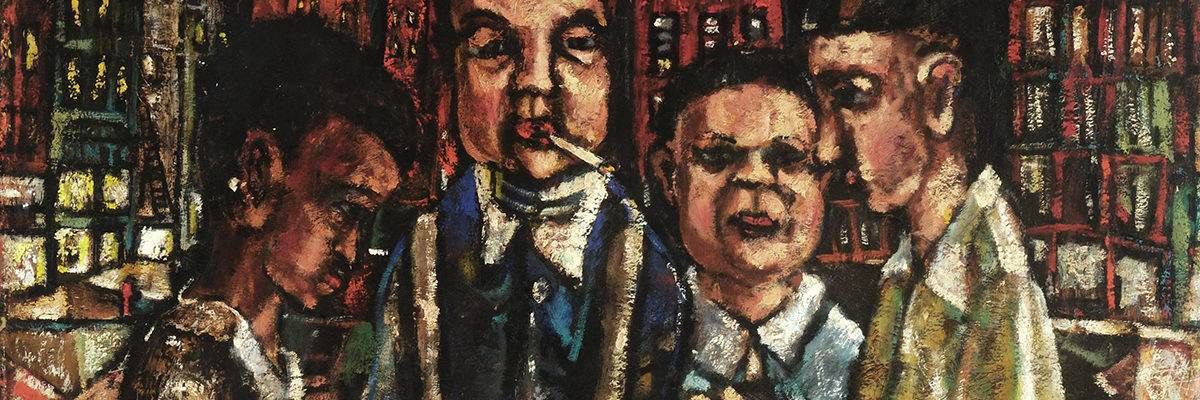February 6–May 9

David C. Driskell (American, 1931–2020), Young Pines Growing, 1959, oil on canvas, Clark Atlanta University Art Museum. © Estate of David C. Driskell.
Born in Eatonton, Georgia, David Driskell (1931–2020) was a revered American artist whose work inspired generations of artists and audiences alike. Icons of Nature and History reveals the artist’s aesthetic inheritances from home, family, the South, and his formative education—at Howard University, Skowhegan School of Painting and Sculpture, and the Catholic University of America—as well as the influence of his sojourns to Europe, Africa, and South America. His artistic evolution is marked by distinctive eras, experiences, and experiments with media. What remains steadfast in his paintings and collages is a commitment to a symbolic form that elevates the mind and the spirit above that which exists in the physical world: these are Driskell’s icons.
Spanning seven decades, this survey of Driskell’s art moves the center of critical art history to Driskell’s arenas: Washington, DC; Talladega, Alabama; Nashville, Tennessee; Hyattsville, Maryland; and Falmouth, Maine. In so doing, it invites us to see American art more comprehensively and to appreciate the contributions of historically Black colleges and universities to this canon. Artists have the vision to see beyond the ordinary, Driskell tells us. Among the many gifts he bequeaths to us is the delight of seeing the world through his eyes, and it is a journey of immeasurable beauty and grace.
See it first and free! Register today for the David Driskell Member Preview Day on Friday, February 5. Visit high.org/event/driskell-preview for details.
Exhibition Catalogue
David Driskell: Icons of Nature and History is available for purchase at the Museum Shop and at museumshop.high.org. Members receive 10% off Shop purchases.
CURATOR’S CHOICE:
FAVORITE OBJECTS IN THE EXHIBITION
Banner image: City Quartet (detail), 1953, oil on canvas, David C. Driskell Center at the University of Maryland, College Park. © The Estate of David C. Driskell.
City Quartet reflects the influence of Jack Levine, with whom Driskell studied at Skowhegan, as well as Loïs Mailou Jones, who first encouraged Driskell to experiment with using both brush and palette knife. Some art historians see the figure on the left as Driskell, whose cityscapes visualize his meditations on his place in the world. At this time, he was a twenty-something art student from Southern Appalachia making his way in the creative metropolis.

David C. Driskell (American, 1931–2020), Behold Thy Son, 1956, oil on canvas, collection of the Smithsonian National Museum of African American History and Culture, Washington, DC. © Estate of David C. Driskell, courtesy of DC Moore Gallery, New York.
Young Pines Growing, 1959, oil on canvas, Clark Atlanta University Art Museum. © Estate of David C. Driskell.
Driskell entered Young Pines Growing into the eighteenth Atlanta University Annual, a juried competition established in 1942 by Hale Woodruff at Atlanta University, now Clark Atlanta University. The entry received the John Hope Purchase Award for best landscape. Driskell’s award-winning composition, more totemic than topographical, traces the agile slim trunks of the pines and their pale new growth against a bright, open sky. The competition provided critical exposure for African American artists and a national stage for artists in the region, such as Driskell, who was then on the faculty of Talladega College.
Behold Thy Son, 1956, oil on canvas, Smithsonian, National Museum of African American History and Culture, Washington, DC. © Estate of David C. Driskell, courtesy of DC Moore Gallery, New York.
Behold Thy Son pays homage to Emmett Till, a fourteen-year-old boy whose brutal murder in Mississippi in 1955 brought national attention to racial violence and injustice in America and especially the South. Driskell’s symbolic rendering brings Till’s death in communion with Jesus’s sacrifice as the man of sorrows. Painted in dark hues, the central figures, and the nearby sarcophagus and candelabra, instill the painting with the somber but sacred quality of a pietà or a Crucifixion. The painting’s title refers to a biblical account of the Crucifixion (John 19:26): “Woman, behold thy son!” Drawings Driskell completed the same year, Behold Thy Son, I and Study for Behold Thy Son, expand our understanding of the artist’s approach to this iconic Christian subject.
Self Portrait as Beni (“I Dream Again of Benin”), 1974, egg tempera, gouache, and collage on paper, High Museum of Art, Atlanta, purchase with David C. Driskell African American Art Acquisition Fund, 2015.74. © Estate of David C. Driskell, courtesy of DC Moore Gallery, New York.
Self-Portrait as Beni brings the artist and the ancient Benin kingdom together as one. Driskell visited Benin City (formerly Edo, capital of the Kingdom of Benin) in 1970. Here he combines a modern self-portrait (on the right) with an ancient, ornamental Benin hip mask (on the left). Annotations on the back of the painting include the date of its completion and a poem, “I Dreamed Again of Benin.” With both art forms, poetry and collage painting, Driskell pays homage to the ancient people of an empire whose countenances evoke dignity and pride.

David Driskell (American, 1931–2020). Self-Portrait as Beni (“I Dream Again of Benin”), 1974, egg tempera, gouache, and collage, High Museum of Art, Atlanta, purchase with David C. Driskell African American Art Acquisition Fund, 2015.74. © Estate of David C. Driskell. Courtesy DC Moore Gallery, New York.
RELATED PROGRAMS
Free for Museum members. Preregistration required for all programs. Please go to high.org for details.
THURSDAY, FEBRUARY 4, 6 P.M., ZOOM
Driskell Prize Lecture: Jamal Cyrus—“Phylacteries to Repel Ghosts”
Don’t miss this program featuring 2020 Driskell Prize winner Jamal Cyrus. Cyrus will cover the important role autodidacticism plays within his work and in Black American culture at large.
The Driskell Prize, named for the renowned African American artist and art scholar, was established by the High in 2005 as the first national award to celebrate an early- or midcareer scholar or artist whose work makes an original and important contribution to the field of African American art or art history. Since the prize’s inception, the funds have supported the acquisition of fifty works by African American artists for the High’s collection.
THURSDAY, FEBRUARY 18, 6 P.M., ZOOM
Curatorial Conversation: Julie McGee and Michael Rooks
Mark your calendar for a special curatorial conversation examining the High’s exhibition David Driskell: Icons of Nature and History. Art historian and exhibition curator Julie McGee will join Michael Rooks, the High’s Wieland Family Curator of Modern and Contemporary Art, to discuss the work and Driskell’s lasting contributions to the art world.
Julie McGee, an art historian with specialties in African American art and contemporary African art, has published widely on contemporary African American art and South African art, with particular focus on artist and museum praxis. She is Associate Professor of Africana Studies and Art History at the University of Delaware and director at the Interdisciplinary Humanities Research Center College of Arts & Sciences.
